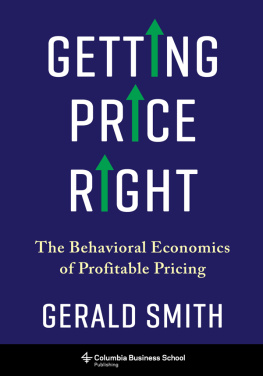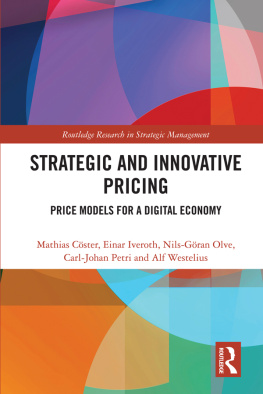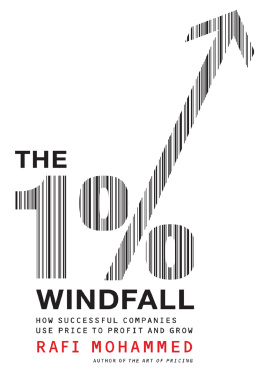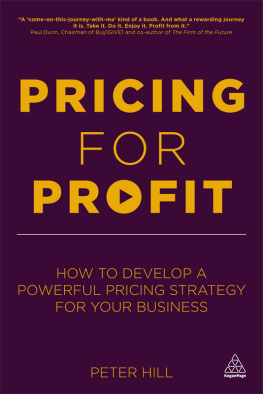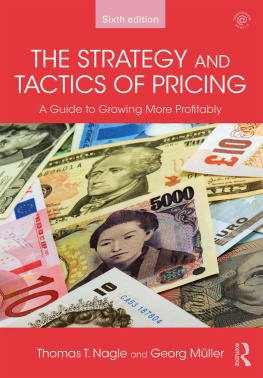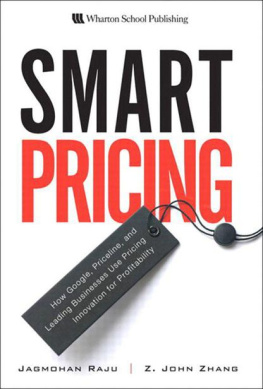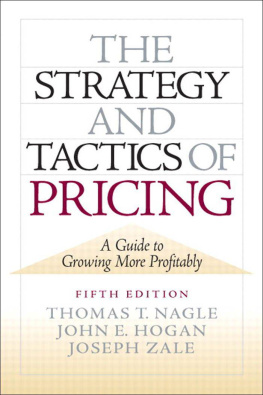Table of Contents
GETTING PRICE RIGHT
Praise for Getting Price Right
Gerald Smith shines light on the psychological biases that have long made pricing as much art as science. Drawing the link between behavioral economics and pricing theory, he explains how to take advantage of the quirks that motivate consumers to, for example, pony up for a subscription to shave butter instead of buying cheaper shaving cream at the drugstore. At the same time, Smith uncovers the competing magnetic forces that explain why finance, marketing, and accounting managers each seem to approach pricing problems from a different planet and how to optimize among their competing influences in the organization. Getting Price Right steers new managers through the foundations of profitable pricing while offering new tricks for experts in readable prose with intuitive examples.
SAMUEL ENGEL, SENIOR VICE PRESIDENT, ICF
There are introductory books available for people new to pricing and higher-level books for people who want to get into the theory of pricing and analytics. What has been missing is an advanced pricing-strategy book that connects practical everyday pricing approaches with academic scholarship. Smith has done just that. This is an excellent read for all pricing stakeholders looking to better understand how pricing fundamentals like customer value and willingness to pay intersect with the evolving science of behavioral economics.
KIRK JACKISCH, PRESIDENT, IRIS PRICING SOLUTIONS
This book makes a strong contribution to pricing knowledge by bridging the bodies of pricing and behavioral science with a unique focus on pricing orientation. It proposes a comprehensive and structured review of critical concepts with practical recommendations and examples on how to use them in real business life. This is a must-have book for any pricing practitioners library.
STEPHAN M. LIOZU, FOUNDER OF VALUE
INNORUPTION ADVISORS AND AUTHOR OF TEN
PRICING BOOKS INCLUDING B2G PRICING
Columbia University Press
Publishers Since 1893
New YorkChichester, West Sussex
cup.columbia.edu
Copyright 2021 Gerald E. Smith
All rights reserved
EISBN 978-0-231-54907-3
Library of Congress Cataloging-in-Publication Data
Names: Smith, Gerald E., 1953- author.
Title: Getting price right : the behavioral economics of
profitable pricing / Gerald Smith.
Description: New York : Columbia University Press, [2021] | Includes index.
Identifiers: LCCN 2021011180 (print) | LCCN 2021011181 (ebook) |
ISBN 9780231190701 (hardback) | ISBN 9780231549073 (ebook)
Subjects: LCSH: Pricing. | EconomicsPsychological aspects.
Classification: LCC HF5416.5 .S583 2021 (print) | LCC HF5416.5 (ebook) |
DDC 658.8/16dc23
LC record available at https://lccn.loc.gov/2021011180
LC ebook record available at https://lccn.loc.gov/2021011181
A Columbia University Press E-book.
CUP would be pleased to hear about your reading experience with this e-book at .
Cover design: Noah Arlow
CONTENTS
Over a half century, strategic pricing has become broadly accepted as one of the most influential and important paradigms of business management. Yet pricing strategy remains elusive for many companies, everyday managers, and entrepreneurs. Despite extensive training and experience in business, many firms fail to formulate, articulate, or design pricing strategy. One reason, it turns out, has little to do with economics and business and much more to do with psychologythe behavioral side of human decision-making. Behavioral economics has surged into the consciousness of policy makers, business managers, and medical professionals with concepts such as framing, confirmation bias, nudging, loss aversion, the sunk cost fallacy, and many others. Even Daniel Kahneman, awarded the Nobel Prize in Economics in 2002, was not an economist but a Princeton University psychologist who applied groundbreaking psychological insights to economic theory.
We know a lot about strategic pricing but much less about behavioral pricing and how managers approach price-setting. This behavioral aspect is largely hidden in the journals of academia and typically studied from the perspective of consumer behavior, not managerial behaviorbut my focus here is managerial price-setting. For example, price framing is a ubiquitous behavioral price-setting skill using comparative pricing information stored in memory, such as setting the sale price of your home using the recent sale price of a neighbors home as a convenient frame of reference called price framing. Or consider the auto industrys successful reference framing strategy to reframe selected used cars as certified pre-owned (CPO) cars that offer almost new car dependability (backed by an extended warranty, an inspection, and the option to return the car if you are unsatisfied) at a premium used-car priceCPO cars typically sell for $500 to a couple of thousand dollars extra, all due to framing.
Behavioral economics especially illuminates the mental shortcuts, heuristics, and biases that each of us infuses, unconsciously, into the process of price-setting. Those who have pricing authority and responsibilitydivision leaders, managers, proprietors, and entrepreneurssubconsciously form attitudes about pricing during their career journeys, perhaps in finance, accounting, marketing, selling, or production. They consequently form beliefs about what price-setting is and how it should be managed, and they subconsciously assume that they are generally right. Usually, however, their attitudes are narrow and short-sighted, leading to imperceptible cognitive biases that go unnoticed or seem inconsequential at the time but that grow over time and subtly undermine pricing effectiveness and the pricing morale of employees, team members, managers, and leaders. Instead of narrowing our focus, we need to diversify our thinking about price-settingto debias pricing by inviting new insights and fresh views of the same pricing problem with conflicting and contradictory perspectives.
The key to exploring these ideas is a new conceptual approach grounded in behavioral economics termed pricing orientation, which relates to how pricing actually happens and how it gets done. It is usually manifested in intuitive and behavioral pricing practicessometimes spontaneous and extemporaneous, but other times long-established behavioral pricing patterns that become well-worn ruts that are hard to steer out of. In this new paradigm, pricing orientation invites managers to ask, how does pricing get done around here? With training and insight, informed by behavioral economic theory, your biases can become behavioral pricing skills that strengthen and shape smart pricing strategy.
This book has been years in the making, and I have benefited by many along the way. First, I want to thank my colleagues and students at Boston College with whom I have shared pricing research findings, strategies, and stories. I have learned so much from our discussions in and out of the classroom, in independent study projects, and in pricing in the news that students continue to share with me years after their graduation. I am grateful to clients who have opened their pricing experiences to discuss, explore, and experiment with new and better pricing practices and outcomes; Ray Mancini and the Mancini family have been especially helpful.

